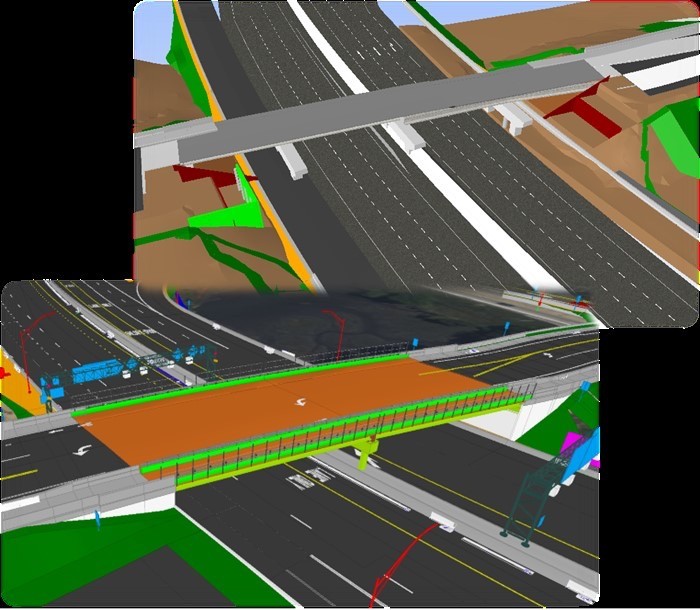Contributor: Alicia Lopez, PE, PEng, DBIA; Vice President, Design Management & Innovation; Flatiron Construction

VP, Design Management & Innovation
Flatiron Construction
In a landmark move toward embracing the digital age, the Biden-Harris administration has initiated the first round of an $85 million grant program to fuel the widespread adoption of digital construction technologies within the transportation sector. This program, launched by the Federal Highway Administration (FHWA), seeks to empower state departments of transportation with cutting-edge technologies, thereby revolutionizing the construction industry and driving efficiency in project delivery. The FHWA grant funding has significant potential to pave the way for the construction industry’s digital transformation.
The Advanced Digital Construction Management Systems (ADCMS) Grant program represents a monumental leap forward for the construction industry’s digital transformation and provides an incentive for state departments of transportation to move into digitalization. By incentivizing and supporting the implementation of advanced digital technologies, the FHWA aims to streamline construction processes, reduce project timelines, optimize resource utilization and enhance overall project delivery efficiency.
One of the primary goals of the FHWA grant funding is to promote Building Information Modeling (BIM) and other innovative digital construction technologies. BIM enables design-build teams to create intelligent and detailed models of infrastructure projects that serve as a digital project deliverable, allowing a virtual design and construction process to come to life. With the FHWA grant’s support, state transportation departments can leverage BIM and related technologies to achieve design excellence, increased quality and greater productivity while improving decision-making throughout the project’s lifecycle as outlined in DBIA’s Primer on Virtual Design & Construction. When technology can be combined with the “whole team approach” inherent in design-build, it can provide the needed environment of transparency and collaboration for BIM and VDC to flourish. Thus, an integrated project team of key stakeholders can create a platform where the team embraces all the client’s goals from the outset.

Additionally, the FHWA grant program could expedite the implementation of Internet of Things (IoT) devices, sensors and real-time data analytics. These advancements enable construction teams to monitor project progress, assess equipment performance and identify potential issues in real time. Incorporating IoT technologies will foster a data-driven approach to construction, allowing stakeholders to make informed decisions promptly and efficiently.
Driving Efficiency Through Digital Transformation
The construction industry has long faced challenges such as cost overruns, schedule delays and communication gaps. The FHWA grant funding provides a unique opportunity for transportation projects to overcome these hurdles and drive efficiency by adopting digital construction technologies.
- Enhanced Collaboration: Digital construction technologies enable seamless collaboration among various project stakeholders, including architects, engineers, contractors and subcontractors. By sharing a unified digital platform, teams can exchange information in real time, minimizing miscommunications and fostering a more collaborative work environment.
- Improved Project Visualization: BIM and 3D modeling empower teams to visualize projects comprehensively before construction begins. This enhanced visualization aids in identifying potential clashes and design issues early in the process, mitigating costly rework and redesigns.
- Data-Driven Decision Making: Embracing digital technologies equips construction teams with a wealth of data that can be analyzed to make informed decisions. By harnessing real-time data, project managers can optimize resource allocation, identify areas of improvement and enhance overall project efficiency.
- Safer Job Sites: Digital construction technologies promote safer job sites by offering enhanced risk analysis capabilities. By identifying potential safety hazards in advance, construction teams can implement preventive measures, reducing the risk of accidents and injuries.
- Sustainable Practices: The integration of digital technologies allows for the implementation of sustainable construction practices. Transportation design-build teams can contribute to a greener and more sustainable future by optimizing material usage, resource allocation and energy consumption.
The integration of the design-build delivery model with digital transformation and collaboration, as facilitated by the FHWA grant program, represents a groundbreaking advancement in the construction industry.

The Role of State Departments of Transportation
State departments of transportation play a pivotal role in driving the adoption of digital construction technologies in the transportation sector. As the entities responsible for the end-to-end management of construction projects, they are uniquely positioned to leverage technology effectively.
With the recent FHWA grant funding, state departments of transportation have an unprecedented opportunity to invest in the latest digital tools and technologies. This funding can be used to train personnel in using these technologies effectively, encourage innovation within the industry and develop best practices for seamlessly integrating digital tools into project workflows.
Some states are already working toward digital delivery, and FHWA grant funding has the potential to catalyze those efforts in other states. For instance, the Pennsylvania Department of Transportation (PennDOT) has evolved to see the value of design-build following the collapse of the Fern Hollow Bridge. By reopening the heavily traveled bridge in less than 11 months, they are moving towards a digital delivery model for transportation projects. PennDOT’s 3D2025 directive establishes that “by 2025, construction projects [under PennDOT] will be bid using 3D technology and no longer be in a traditional construction plan format.”
Conclusion
The FHWA’s Advanced Digital Construction Management Systems (ADCMS) grant program marks a momentous step toward transforming the transportation industry. By empowering the state departments of transportation with advanced digital tools and technologies, the grant funding aims to enhance collaboration, drive efficiency and facilitate data-driven decision-making throughout the project lifecycle.
Embracing digital transformation will lead to improved project outcomes and contribute to a more sustainable and technologically advanced construction industry. As construction professionals harness the power of digital innovation, they will be at the forefront of shaping the future of transportation infrastructure development.

